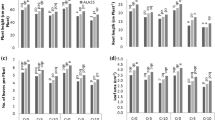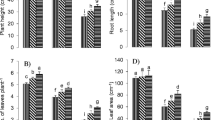Abstract
Chromium (Cr) stress is one of the most adverse environmental factors that affect plant growth and food chain contamination. Fulvic acid (FA) is known to enhance the growth and production of crops, but the studies are scare regarding the application of FA on metal tolerance in plants. The effects of FA application on alleviating Cr phytotoxicity in wheat plants were investigated in a pot experiment conducted in sand- and soil-grown plants. Three Cr (0, 0.25, and 0.50 mM) treatments in the form of K2Cr2O7 were applied in both soils with or without foliar application of 1.5 mg L−1 FA. Plants were harvested after 4 months of treatments, and data regarding growth characteristics, biomass, photosynthetic pigments, and antioxidant enzymes were recorded. FA application increased plant biomass, photosynthetic pigments, and antioxidant enzymes while it decreased Cr uptake and accumulation in plants as compared with Cr treatments alone. We conclude that FA application contributes to decreased Cr concentrations in wheat grains and could be used as an amendment when aiming for decreased metal concentration in plants.





Similar content being viewed by others
References
Aebi H (1984) Catalase in vitro. Methods Enzymol 105:121–126
Ali S, Zeng F, Cai S, Qiu B, Zhang GP (2011) The interaction of salinity and chromium in the influence of barley growth and oxidative stress. Plant Soil Environ 57:153–159
Ali S, Cai S, Zeng F, Qiu B, Zhang G (2012) Effect of salinity and hexavalent chromium stresses on uptake and accumulation of mineral elements in barley genotypes differing in salt tolerance. J Plant Nutr 35:827–839
Ali S, Farooq MA, Jahangir MM, Abbas F, Bharwana SA, Zhang GP (2013a) Effect of chromium and nitrogen form on photosynthesis and anti-oxidative system in barley. Biol Plant 57:785–791
Ali S, Farooq MA, Yasmeen T, Hussain S, Arif MS, Abbas F, Bharwana SA, Zhang GP (2013b) The influence of silicon on barley growth, photosynthesis and ultra-structure under chromium stress. Ecotoxicol Environ Safe 89:66–72
Al-Othman ZA, Ali R, Al-Othman AM, Ali JA, Habila M (2012) Assessment of toxic metals in wheat crops grown on selected soils, irrigated by different water sources. Arabian J Chem. doi:10.1016/j.arabjc.2012.04.006
Anita S, Rajesh KS, Madhoolika A, Fiona MM (2010) Health risk assessment of heavy metals via dietary intake of foodstuffs from the wastewater irrigated site of a dry tropical area of India. Food Chem Toxicol 48:611–619
Bradford MM (1976) A rapid and sensitive method for the quantification of microgram quantities of protein utilizing the principle of protein-dye binding. Anal Chem 72:248–254
Das AK (1990) Metal ion induced toxicity and detoxification by chelation therapy, a textbook on medical aspects of bioinorganic chemistry. CBS, Delhi, pp 17–58
Dey SK, Jena PP, Kundu S (2009) Antioxidative efficiency of Triticum aestivum L. exposed to chromium stress. J Environ Biol 30:539–544
Diwan H, Ahmad A, Iqbal M (2012) Characterization of chromium toxicity in food crops and their role in phytoremediation. J Bioremed Biodeg 3:159. doi:10.4172/2155-6199.1000159
Ehsan S, Ali S, Noureen S, Farid M, Shakoor MB, Aslam A, Bharwana SA, Tauqeer HM (2013) Comparative assessment of different heavy metals in urban soil and vegetables irrigated with sewage/industrial waste water. Ecoterra 35:37–53
Ehsan S, Ali S, Noureen S, Mehmood K, Farid M, Ishaque W, Shakoor MB, Rizwan M (2014) Citric acid assisted phytoremediation of Cd by Brassica napus L. Ecotoxicol Environ Safe 106:164–172
El-Ghamry AM, Abd El-Hai KM, Ghoneem KM (2009) Amino and humic acids promote growth, yield and disease resistance of faba bean cultivated in clayey soil. Aust J Basic Appl Sci 3:731–739
Evangelou MWH, Daghan H, Schaeffer A (2004) The influence of humic acids on the phytoextraction of cadmium from soil. Chemosphere 57:207–213
Faisal M, Hasnain S (2005) Microbial conversion of Cr (VI) in to Cr (III) in industrial effluent. Afr J Biotechnol 3:610–617
FAOSTAT (2014) http://faostat3.fao.org/download/Q/QC/E
Farid M, Ali S, Shakoor MB, Bharwana SA, Rizvi H, Ehsan S, Tauqeer HM, Iftikhar U, Hannan F (2013) EDTA assisted phytoremediation of cadmium, lead and zinc. Int J Agron Plant Prod 4:2833–2846
Garnier L, Simon-Plas F, Thuleau P, Agnel JP, Blein JP, Ranjeva R (2006) Cadmium affects tobacco cells by a series of three waves of reactive oxygen species that contribute to cytotoxicity. Plant Cell Environ 29:1956–1969
Gill RA, Zang L, Ali B, Farooq MA, Cui P, Yang S, Zhou W (2015) Chromium-induced physio-chemical and ultrastructural changes in four cultivars of Brassica napus L. Chemosphere 120:154–164
Habiba U, Ali S, Farid M, Shakoor MB, Rizwan M, Ibrahim M, Abbasi GH, Hayat T, Ali B (2015) EDTA enhanced plant growth, antioxidant defence system and phytoextraction of copper by Brassica napus L. Environ Sci Pollut Res 22:1534–1544
Halim M, Conte P, Piccolo A (2003) Potential availability of heavy metals to phytoextraction from contaminated soils induced by exogenous humic substances. Chemosphere 52:265–275
Halliwell B, Gutteridge JMC (1999) Free radicals in biology and medicine, 4th edn. Oxford University Press, New York
Hegedus A, Erdel S, Horvath G (2001) Comparative studies of H2O2 detoxifying enzymes in green and greening barely seedlings under Cd stress. Plant Sci 160:1085–1093
Islam F, Yasmeen T, Riaz M, Arif MS, Ali S, Raza SH (2014) Proteus mirabilis alleviates zinc toxicity by preventing oxidative stress in maize (Zea mays) plants. Ecotoxicol Environ Safe 110:143–152
Iyer VG, Mastorakis NE (2010) Unsafe chromium and its environmental health effects of Orissa chromate mines, Proceedings of the International Conference on Recent Advances Energy and Environmental Technologies and Equipment. Universitatea Politehnica, Bucharest, Romania, pp 111–122
Kanwal U, Ali S, Shakoor MB, Farid M, Hussain S, Yasmeen T, Adrees M, Bharwana SA, Abbas F (2014) EDTA ameliorates phytoextraction of lead and plant growth by reducing morphological and biochemical injuries in Brassica napus L. under lead stress. Environ Sci Pollut Res 21:9899–9910
Katkat AV, Çelik H, Turan MA, Asik BB (2009) Effects of soil and foliar applications of humic substances on dry weight and mineral nutrients uptake of wheat under calcareous soil conditions. Aust J Basic Appl Sci 3:1266–1273
Khan S, Cao Q, Zheng YM, Huang YZ, Zhu YG (2008) Health risks of heavy metals in contaminated soils and food crops irrigated with wastewater in Beijing, China. Environ Pollut 152:686–692
Khan MY, Asghar HN, Jamshaid MU, Akhtar MJ, Zahir ZA (2013) Effect of microbial inoculation on wheat growth and phytostabilization of chromium contaminated soil. Pak J Bot 45(S1):27–34
Kleber M, Johnson MG (2010) Advances in understanding the molecular structure of soil organic matter: implications for interactions in the environment. Adv Agron 106:77–142
Lichtenthaler HK (1987) Chlorophylls and carotenoids pigments of photosynthetic biomembranes In: Colowick SP, Kaplan NO (ed.). Methods Enzymol 148:350–382
Matysiak K, Kaczmarek S, Krawczyk R (2011) Influence of seaweed extracts and mixture of humic and fulvic acids on germination and growth of Zea mays L. Acta Sci Pol Agric 10:33–45
Melamed R, Cao X, Chen M, Ma LQ (2003) Field assessment of lead immobilization in a contaminated soil after phosphate application. Sci Total Environ 305:117–127
Metzner H, Rau H, Senger H (1965) Untersuchungen zur Synchronisierbakeit einzelner Pigmentmangel-Mutation von Chlorella. Planta 65:186–194 (in German)
Middleton EM, Teramura AH (1993) The role of flavonol glycosides and carotenoids in protecting soybean from UV-B damage. Plant Physiol 103:741–752
Morales J, Manso JA, Cid A, Mejuto JC (2012) Degradation of carbofuran and carbofuran-derivatives in presence of humic substances under basic conditions. Chemosphere 89:1267–1271
Nagajyoti PC, Lee KD, Sreekanth TVM (2010) Heavy metals occurrence and toxicity for plants: a review. Environ Chem Lett 8:199–216
Nakano Y, Asada K (1981) Hydrogen peroxide is scavenged by ascorbate specific peroxidase in spinach chloroplasts. Plant Cell Physiol 22:867–880
Nardi S, Pizzeghello D, Muscolo A, Vianello A (2002) Physiological effects of humic substances on higher plants. Soil Biol Biochem 34:1527–1536
Oliveira H (2012) Chromium as an environmental pollutant: insights on induced plant toxicity. J Bot. doi:10.1155/2012/375843
Reddy AM, Kumar SG, Jyothsnakumari J, Thimmanaik S, Sudhakar C (2005) Lead induced changes in antioxidant metabolism of horsegram (Macrotyloma uniflorum (Lam.) Verdc.) and bengalgram (Cicer arietinum L.). Chemosphere 60:97–104
Shahid M, Pourrut B, Dumat C, Winterton P, Pinelli E (2011) Lead uptake, toxicity and detoxification in plants. Rev Environ Contam Toxicol 213:113–136
Shahid M, Dumat C, Silvestre J, Pinelli E (2012) Effect of fulvic acids on lead-induced oxidative stress to metal sensitive Vicia faba L. plant. Biol Fert Soils 48:689–697
Shakoor MB, Ali S, Farid M, Farooq MA, Tauqeer HM, Iftikhar U, Hannan F, Bharwana SA (2013) Heavy metal pollution, a global problem and its remediation by chemically enhanced phytoremediation: a review. J Biodiver Environ Sci 3:12–20
Shakoor MB, Ali S, Hameed A, Farid M, Hussain S, Yasmeen T, Najeeb U, Bharwana SA, Abbasi GH (2014) Citric acid improves lead (Pb) phytoextraction in Brassica napus L. by mitigating Pb-induced morphological and biochemical damages. Ecotoxicol Environ Safe 109:38–47
Shanker AK, Cervantes C, Loza-Tavera H, Avudainayagam S (2005) Chromium toxicity in plants. Environ Int 31:739–753
Sharma P, Pandey S (2014) Status of phytoremediation in world scenario. Int J Environ Bioremed Biodeg 2:178–191
Suganya S, Sivasamy R (2006) Moisture retention and cation exchange capacity of sandy soil as influenced by soil additives. J Appl Sci Res 2:949–951
Tang WW, Zeng GM, Gong JL, Liang J, Xu P, Zhang C, Huang BB (2014) Impact of humic/fulvic acid on the removal of heavy metals from aqueous solutions using nanomaterials: A review. Sci Total Environ 468:1014–1027
Weng LP, Van Riemsdijk WH, Koopal LK, Hiemstra T (2006) Adsorption of humic substances on goethite: comparison between humic acids and fulvic acids. Environ Sci Technol 40:7494–7500
Yadav K, Singh NB (2013) Effects of benzoic acid and cadmium toxicity on wheat seedlings. Chil J Agric Res 73:168–174
Zeng FR, Zhao FS, Qiu BY, Ouyang YN, Wu FB, Zhang GP (2011) Alleviation of chromium toxicity by silicon addition in rice plants. Agric Sci China 10:1188–1196
Acknowledgment
This study is part of the M.Sc Environmental Sciences Thesis of Sidra Kanwal. We are highly thankful to the Higher Education Commission (HEC), Pakistan, and Government College University, Faisalabad, Pakistan, for their financial support.
Author information
Authors and Affiliations
Corresponding author
Additional information
Responsible editor: Elena Maestri
Rights and permissions
About this article
Cite this article
Ali, S., Bharwana, S.A., Rizwan, M. et al. Fulvic acid mediates chromium (Cr) tolerance in wheat (Triticum aestivum L.) through lowering of Cr uptake and improved antioxidant defense system. Environ Sci Pollut Res 22, 10601–10609 (2015). https://doi.org/10.1007/s11356-015-4271-7
Received:
Accepted:
Published:
Issue Date:
DOI: https://doi.org/10.1007/s11356-015-4271-7




